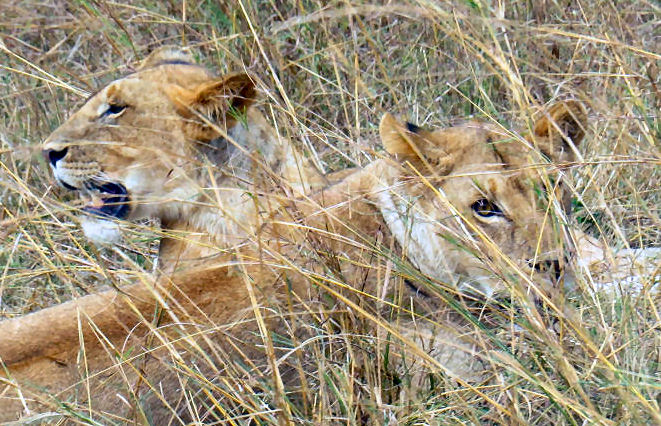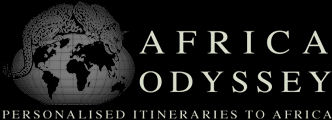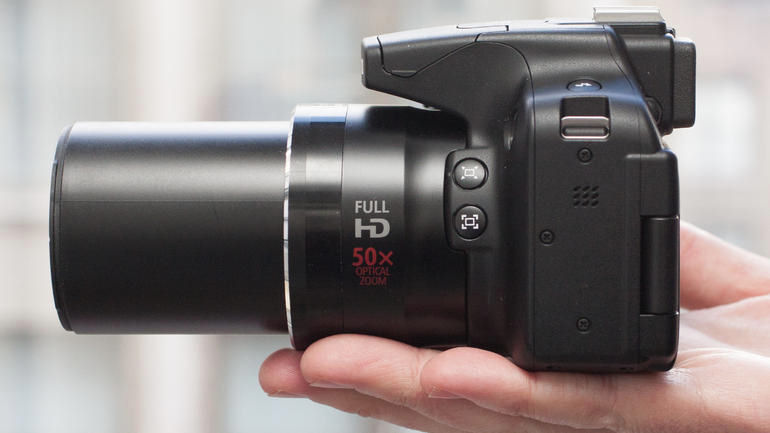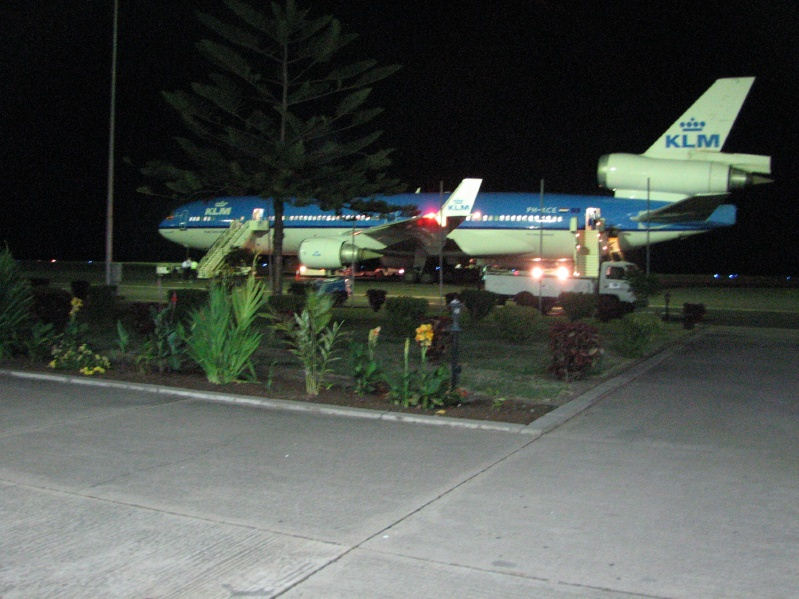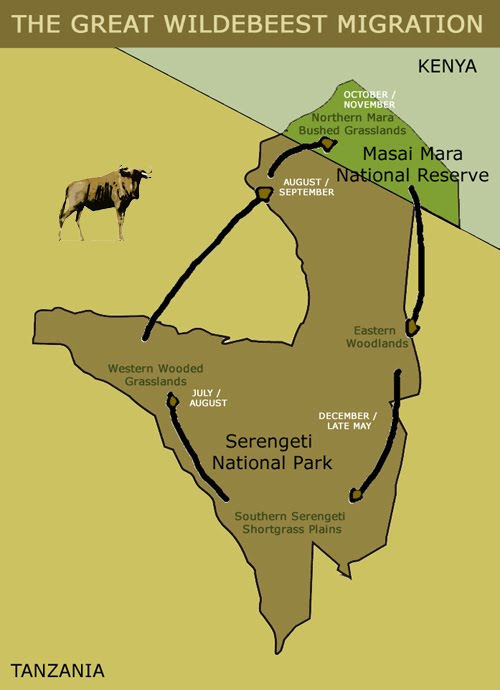I had been planning the trip to Africa for more than three years. The primary objective was to experience the Great Migration[1] as closely as possible. I was aware that the most dramatic aspect of the migration involved the crossing of the Mara River. Other than that, I just wanted to see as many animals in the wild as possible. Who knows how long they will be there?
I bought Fodor's book on planning a safari. My priorities changed a little when I read about Mahale Mountains National Park in the western edge of Tanzania. I learned that it was possible to observe at close range a group of chimpanzees there. The location was certainly remote enough. There are no roads at all in the park. Visitors must fly to an airstrip well north of the park and then take a dhow for a little over an hour down Lake Tanganyika to reach the camps. Fodor's insisted that Greystoke Lodge, although very expensive, was the best way to do this. It specified that arrangements must be made with an approved tour operator. One of those listed was Tanzania Odyssey (now known as Africa Odyssey).
From the beginning five of us — Sue and I, our longtime friend Tom Corcoran, Sue's Sister Betty (a wildlife enthusiast), and her longtime friend Jeff Campbell — were interested. I provided Ted Archdale at Africa Odyssey with a list of my priorities and a budget. He set up an itinerary for us that exceeded the budget by only a small amount. It included all four of my objectives (the migration, Ngorongoro Crater, Mahale, and Katavi National Park) as well as a game drive in Lake Manyara National Park.
It took quite a long time for our group of geezers, of which I was the most senior by more than two years, to get healthy enough to make the trip. By the summer of 2014 Sue decided that her new metallic knees were up to the task, and I contacted Ted to see if it was possible to arrange something on short notice. He said that it was very unlikely. In fact, however, he was, "by some miracle" able to schedule us a trip for September of 2014. Unfortunately, Tom could not fit this into his schedule, and so we postponed our journey for a year. Even so, we had to put down a deposit for Greystoke immediately, and many months before our scheduled departure we needed to pay a 25 percent deposit. In addition, AO insisted that we all purchase travel insurance that would pay to transport us back to the United States in case of a medical emergency.
My preparation for previous trips had always focused on learning as much as possible about each stop and determining how best to use my spare time to enhance the experience. This time everything would be in the hands of others. Ted picked the camps and hotels. We would be dependent on the guides there to show us the sights and the management and staff to tend to our needs.
Nevertheless, there was plenty to do. The big thing for me was a desire to upgrade my camera. My point-and-shoot had a 12x zoom, which was fine for cathedrals, but would likely be inadequate for a safari. I did not want to invest the time and money in an SLR camera. I settled on a Canon SX50. It was only a little more complicated than the one I had been using, and it featured a 50x zoom lens that was easy to use. I also bought a spare battery and a monopod for it. We had heard that the latter could be useful for stabilizing shots from the safari vehicles.
Sue prefers to take movies. She purchased a Go-Pro with a headband. She also took my point-and-shoot Canon with a couple of spare batteries.

Most of the rest of the crew invested in new clothes. Sue and I both bought hats. After all, Tanzania is only a little bit south of the equator. The sun is hot there all year round. On the other hand all of Tanzania resides at a fairly high altitude. The evenings and mornings are surprisingly cool. Because we were scheduled to fly between the camps, we were limited to only 33 pounds of luggage, including carry-ons. Fortunately most of the places in which we stayed advertised that they would wash clients' clothes, except for women's underwear. So, most of us brought only three or four changes of clothes. Mine consisted of old long-sleeved shirts and cheap pants. Sue purchased some soft-sided luggage without wheels for us. The bush planes require this.
The most dangerous animals in Tanzania are insects. We purchased a can of Deet and a can of Permethrin, which is used on clothes. It supposedly lasts two weeks. As part of our medical preparations Sue and I were provided with prescriptions for Malarone, which helps prevent malaria. I ended up needing four vaccinations, two in each arm. Sue only needed two. The UConn Travel Clinic in Farmington was our source for all of this.
Our plan was to fly Delta from Boston to Amsterdam on the evening of Sunday, September 6, the last day of the Regional Tournament in Warwick. Sue and I played bridge there from Tuesday through Friday, which left a lot to do on Saturday and Sunday morning. On Saturday I mowed the lawn, got a large amount of cash[2] for tips, paid all our bills, washed my clothes, packed, and weighed my luggage.
I was up at 4 a.m. I spent part of the time finishing Thrice, a novel I wrote about the eleventh-century pope, Benedict IX. I printed a copy and put it in a binder. I planned to offer it to Tom as reading material on the savanna. I then went back to sleep until 6, at which time I made a quick trip to Walmart to pick up cat food, some combs, and a small can of shaving cream. On the way back I withdrew another $300 from the ATM.
I then spent some quality time with my buddy, Giacomo the cat. He would be staying by himself for another two weeks right after four long days while we were at the bridge tournament. He already seemed to be getting a little neurotic. I just hoped that his fragile psyche would be able to stand the strain. Sue's other sister, Karen, had agreed to make sure that he had food and water.
The last step was to sign on to the Internet and purchase airline tickets for the NABC tournament in Denver in late November and December. These national bridge championships are held three times a year. I sent an e-mail to one of my partners who also planned to attend.
I was ready early. Sue, however, was encountering all kinds of difficulties. I have always tried to avoid her when she gets like this, and so I never learned precisely what her problems entailed.
Tom picked us up at about 1 p.m. Betty, another resident of Enfield, was nearly out of her skin with excitement. She had spent hours memorizing the characteristic of the birds and animals that we might encounter. Our destination was the house of Tom's sister Carol and her husband Mo in Quincy, MA. They had agreed to let Tom leave his car there for the duration of our trip. Getting to their place - or anywhere else in the Boston area - is a challenge, but Tom was up to it.
At Carol's house Tom weighed Sue's bag and discovered that it was too heavy by a pound or two. Her plan had been to stash things in her purple Heifer bag, which was already full, to carry on the plane. She ended up leaving a pair of boots and several sets of underwear (!) in Tom's car rather than risk having to abandon some of her possessions in Africa.
Mo drove the four of us to Logan. Jeff, who lived in the Boston area, met us at Logan. Before we checked in, Sue devoted a few minutes to "reshuffling" her belongings. I took some photos of Sue and Betty bending over in tandem. Like the photos that I took of our luggage and the shots at Mo's and Carol's house, none of these photos appear on this page for reasons that will be apparent soon enough.
For some reason we were all designated by Delta as "pre-screened." We therefore had no problems at all with security.
Sue and I lucked out on the Delta flight to Amsterdam. We were assigned two middle seats in the center section, which would ordinarily be the worst possible situation. However, since neither of the two seats around us was occupied, we had the whole row, as well as four pillows and blankets, to ourselves. This allowed us to place our carry-ons to the side and stretch out our legs beneath the seat in front of us. Sue was actually able to lie down on three seats after I moved to the aisle.
The safety presentation, which you can see here, was by far the most enjoyable that I have ever seen.
The flight attendants served supper to us just after takeoff and breakfast from a snack box just before touchdown. I felt comfortable enough to get a little sleep during the long interval between meals. I also snapped a few photos of the interior of the plane.
The flight attendants handed out little packages that contained a sleep mask and earplugs. I already had my own eyemask out, and so I put them in my backpack. The sleep mask was much nicer than ones that I received on previous Atlantic crossings.
We landed in Amsterdam Airport Schiphol right on time. We gathered together our carry-on stuff from amidst the pillows and blankets and exited the plane in something of a mental fog. The flight had been seven hours in duration, and we had lost an additional five hours because we were going east.
After a short bathroom break we made the very long walk through the airport to Gate E9 for our KLM flight to Mt. Kilimanjaro Airport in Tanzania. We had a couple of hours to kill. I decided to take some photos. When I opened my backpack I realized that I had left my camera case, which contained my new camera, a cable for my iPod, a spare battery, the battery charger, and cleaning equipment for the lens, on the plane. I managed to utter only two words, "Oh, no!"
I made the long trek back to the Delta gate, which I remembered as D47 or something very close to that. I jogged most of the way, and once I even high-stepped over the railing of the moving walkway after I encountered people blocking the way. Even though I sincerely doubted that there was any way of recovering my camera,[3] if there was even a small chance of reclaiming it before departure, I wanted to try it.
I buttonholed a KLM employee near Gate D47. It was not her job, but she tried to help me. She wanted to know the gate number, the flight number, and the seat number. I knew all of those except the gate number. She advised me to go to the "Transfers Desk." I retraced my steps back toward the E gates and found that station. The young lady there gave me a number, B238. I took a seat to watch only three employees dealing with a wide variety of problems encountered by quite a few people. When the next number called was B230, I thought that I might have a chance of having enough time to report my problem, although I was pretty sure that the best that I could hope for was a Lost & Found form. At least ten minutes went by before they called the next person, and the number was not B231, it was T15. I gave up and went back to the gate.

By this time only a few minutes remained until the boarding process started. It is possible that I might have been able to purchase a new camera somewhere in the huge airport, but there was not enough time remaining to explore that possibility. I was crestfallen, but, believe it or not, this was not the low point of the trip for me.
One bizarre aspect of the situation was that a gentleman who greatly resembled my deceased father was seated quite near to us in the waiting area. He was not a live-ringer, but he certainly looked more like my dad than anyone else that I had ever seen.
Meanwhile Sue had reported the loss of my camera at the desk at E9. They checked their computers, but nothing had turned up. They told us that we should check on the Internet at KLM.com/Sherlock.[4]
Sue and I took our seats, both in the middle section,[5] and readied ourselves for the eight-hour flight south. We would lose another hour in transit. I noticed that most of the people on the plane were less than half my age. The flight was quite crowded.
I was hapless on the entire journey. I continually wracked my brain to come up with some plan for salvaging the vacation. Meanwhile, I could not get the remote control out of the armrest, and I was unable to open most of the food containers without using my teeth. My Coca Cola Light was, not surprisingly,[6] lukewarm. I found most of the food hardly worth the effort of opening the packages. The "Dutch pizza" that they supplied for the supper was the worst of the lot. I did appreciate the free wine, however.
It was after 7:30 in the evening when we arrived at Kili, a very small airport. It had the old-fashioned portable staircases rather than ramps. We marched across the tarmac and managed to find our luggage without any difficulty.
While the rest of us searched for our bags, Betty went outside to sneak a smoke and to locate the representative from Asilia who was supposed to meet us.[7] She found them, a woman named Joyce and a man named Godfrey or something like that. He showed us to his vehicle, and we began the drive to our hotel, Onsea House.[8] He said that it would take about an hour.[9]
The journey was almost entirely along a two-lane paved road. We were a little surprised to discover that Tanzanians drive on the left. The route was quite dark, and there was quite a bit of traffic in both directions going various speeds from quite slow to breakneck. Passing was common and harum-scarum. Along the sides of the road were many small buildings. It appeared that many of them were hosting parties. In short, the experience was a little scary.

It seemed as if the road went on forever. Tom insisted that it was uphill all the way, and maybe it was. Somehow the driver knew to turn onto a dirt road. We drove well past a sign for Machweo. Finally we came to a rather elegant set of buildings well off the road from Nowhere. This was Onsea House, a very nice little hotel. The two Asilia representatives told us that a different person from Asilia would meet us the next morning (Tuesday) at 9 a.m. We told them that we were interested in shopping for a camera in Arusha before the game drive.
The staff greeted us and showed us our room. Sue and I were in #8, which was on the lower level. For obvious reasons I was not able to take photos. Onsea House was proud of its restaurant, but we had eaten supper on the plane, and we wanted a shower and a bed much more than something to eat. I think that the staff was disappointed to learn about our intentions.
The shower was fine, although it was a little off-putting that there were only three walls and no doors. My expectations in this area were not too high. The bed was fine, too, and I slept pretty well, considering what an incredible blunder I had made. I knew that we were scheduled to be in Plantation Lodge for two nights. Maybe I would be able to use Amazon's overnight delivery. Of course, that would require that I would be able to sign on to the Internet somehow, and Amazon would have the wherewithal to get the equipment to a hotel in the African bush.
I took my Malarone pill and my eye vitamins, read a few pages from one of the books that Tom had lent to me, and donned my eye-mask and earplugs. I went to sleep in the very comfortable bed. It was my first night ever sleeping behind a mosquito net.
[1] An enormous group of wildebeests, zebras, and antelopes numbering two million or more annually executes a migration that is roughly oval-shaped. The range is from the far southern portion of Serengeti National Park up to the Masai Mara National Reserve in Kenya. Most people think that the best time and place to experience this fantastic event is in the driest months of August and September when large numbers cross the Mara River.
[2] U.S. dollars are readily accepted.
[3] Several years ago I accidentally left a library book on an airplane, and even though I returned to the correct gate within ten minutes of the completion of the disembarking, I never recovered it. Passengers and crew exit via the front door. The cleaning crew, which is outsourced by most major airlines, enters and exits by the rear door. I suspect that the cleaning crew has very little interaction with anyone in the terminal.
[4] I tried that when we got home. There was no such page.
[5] We purchased our tickets long in advance of the trip. Seat selection was not available at that time, and I neglected to select seats until it was too late to get good ones.
[6] In my experience Europeans do not seem to crave cold beverages the way that Americans do.
[7] I had no idea what kind of company Asilia was, and I did not know how we would make contact. This was what had most worried me about our arrangements.
[8] Our itinerary said that we would be staying at Machweo Wellness Retreat, an affiliated hotel. At this point we were only concerned about finding a bed. Onsea has three syllables: on SAY ah.
[9] This was accurate. The website for Onsea House erroneously claimed that it was a 30-40 minute drive from the airport.
